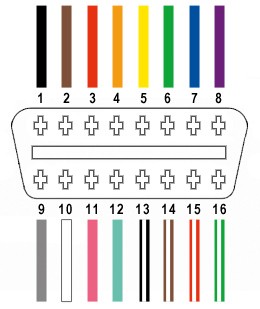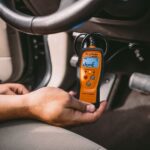Connecting your vehicle to diagnostic tools is crucial for modern car maintenance. While OBD2 (On-Board Diagnostics II) is the standard interface for many vehicles, some systems, particularly in motorcycles or older models, utilize a 4-pin connector. This guide will walk you through creating a custom 4-pin to OBD2 connector, enabling you to use standard OBD2 scanners on these systems. Please note, this is a DIY project and should be undertaken with caution. We are not liable for any damage resulting from this process. Proceed at your own risk.
Tools and Parts You’ll Need
To build your 4-pin to OBD2 adapter, gather the following tools and parts:
- Wire strippers/cutters: Essential for preparing the wires.
- Needle-nose pliers: Helpful for manipulating small components.
- Molex crimping tool (Optional but recommended): For securely crimping connector pins.
- Soldering iron (Recommended): To create a robust and reliable electrical connection.
- 4-pin connector: This will connect to your vehicle’s diagnostic port. (Link to part used; pin/wire size = 22-16AWG; insulation/seal size = 1.3-1.7mm)
- OBD-II Cable: Provides the standard OBD2 connector. (Link to part used)
For cost savings, you can purchase a female OBD-II connector separately and use spare wires for the connection, provided you have the correct wire size for the 4-pin connector.
Understanding the Wiring: 4-Pin to OBD2 Pinout
Out of the 16 pins available on a standard OBD2 connector, we will only be utilizing four for this 4-pin to OBD2 adapter. These are the essential pins for basic diagnostic communication, often related to CAN bus systems:
- Pin 4 (Chassis Ground): Provides the ground reference for the circuit (Orange wire in the linked OBD2 cable).
- Pin 6 (CAN High – J-2284): Carries the CAN bus high signal for communication (Green wire in the linked OBD2 cable).
- Pin 14 (CAN Low – J-2284): Carries the CAN bus low signal for communication (Brown wire with white stripe in the linked OBD2 cable).
- Pin 16 (Battery Power): Supplies power to the OBD2 scanner (Green wire with white stripe in the linked OBD2 cable).
It’s important to note that while this guide provides a functional 4-pin to OBD2 adapter, specific vehicle requirements may vary. Always consult your vehicle’s service manual for precise diagnostic port information.
Step-by-Step Guide to Building Your 4-Pin to OBD2 Connector
Follow these steps to assemble your custom 4-pin to OBD2 connector:
Step 1: Prepare the OBD2 Cable
Begin by preparing the OBD2 cable. Carefully remove the outer sheath and shielding from the OBD2 cable to access the internal wires. Identify and separate the four wires you will need: Orange (Pin 4), Green (Pin 6), Brown with white stripe (Pin 14), and Green with white stripe (Pin 16). Bundle the remaining 12 wires and secure them out of the way using a zip tie to keep your workspace tidy.
Step 2: Preparing the Wires for the 4-Pin Connector
The wires within the OBD2 cable are often 26AWG, which is smaller than the 22AWG size recommended for the pins of the 4-pin connector we are using. To compensate for this difference in wire gauge, carefully strip approximately 3/8″ of insulation from the end of each of the four selected wires. Fold the exposed wire strands over onto themselves, and twist them tightly to effectively thicken the wire. This ensures a better fit and connection within the 4-pin connector pins. Slide a rubber seal (provided with the 4-pin connector kit) onto each wire, orienting it towards the stripped end.
Step 3: Attaching Pins – Soldering or Crimping
Now, attach the pins to the prepared wire ends. The pins for the 4-pin connector have two sets of prongs. The front prongs are designed to crimp onto the wire itself, and the rear prongs crimp onto the rubber seal for strain relief and environmental protection.
Insert the stripped and folded wire into the front section of the pin, ensuring it aligns with the front prongs. Due to the small wire size, using needle-nose pliers to hold the wire in place during this step can be helpful.
Soldering (Recommended): For a more robust and reliable connection, soldering is highly recommended. Solder the wire to the pin connector, ensuring the solder flows and creates a solid bond. Soldering provides excellent electrical conductivity and mechanical strength, particularly beneficial for the smaller gauge wire.
Crimping (Alternative): If you have a Molex crimping tool, you can crimp the front prongs of the pin connector around the wire. If a specialized crimping tool is unavailable, needle-nose pliers can be used carefully to fold the prongs over the wire. Ensure a tight crimp for a good electrical connection. For added security when crimping with pliers, you can gently crush the prongs further once folded.
Step 4: Securing the Seal
Slide the rubber seal up the wire until it sits between the rear prongs of the pin connector. Use the same crimping technique as in Step 3 to fold the rear prongs over the rubber seal. This secures the seal in place, providing strain relief and protecting the connection from moisture and contaminants.
Step 5: Inserting Pins into the 4-Pin Connector Housing
Insert the completed pins into the 4-pin connector housing in the correct orientation as shown below:
- Pin 14 (Brown w/white stripe) > Connector slot A
- Pin 6 (Green) > Connector slot B
- Pin 16 (Green w/white stripe) > Connector slot C
- Pin 4 (Orange) > Connector slot D
Push each pin into the rear of the connector housing until you hear an audible “click,” indicating that the pin is securely locked in place. Using needle-nose pliers to gently pull the wire from the rear can help ensure the pin is fully seated and locked.
Final Assembly and Testing
Congratulations, your 4-pin to OBD2 connector is now complete!
You can now test your new adapter by connecting it to your vehicle’s 4-pin diagnostic port and then connecting an OBD2 scanner to the OBD2 end of the adapter. Successful connection allows you to read and clear diagnostic trouble codes, and access other vehicle data depending on your scanner’s capabilities and your vehicle’s system.
This DIY 4-pin to OBD2 adapter is a valuable tool for accessing diagnostic information on vehicles that utilize a 4-pin diagnostic port. Remember to always double-check your connections and consult your vehicle’s service manual for specific diagnostic procedures. For more automotive DIY guides and diagnostic information, visit obd-de.com.


